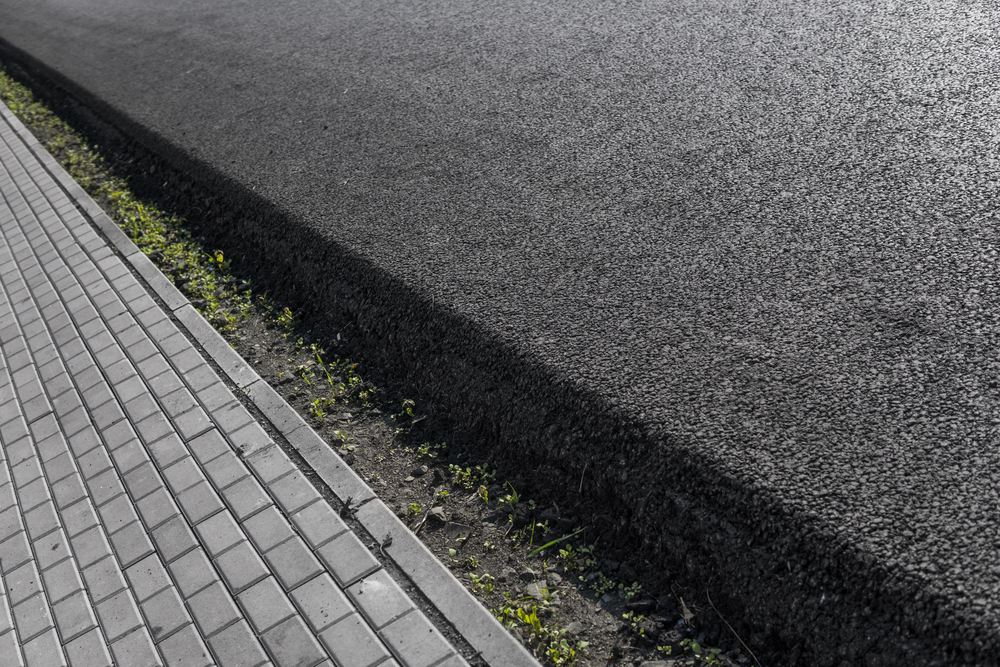Moss can be a problem on tarmac driveways, particularly in areas that tend to stay damp (north facing, under overhanging shrubs and trees, where rainwater pools etc.).
While moss doesn’t do any real damage to the tarmac surface, it is very slippery when wet, so can represent a safety risk. It also arguably looks unsightly and gives your property an “unloved” appearance.
However before you get started trying to remove moss from your tarmac driveway there’s one crucial thing you need to know. Tarmac is actually quite a soft, pliable material for driveways, and can be at risk of serious damage if the wrong process is used.
Follow the tips below to easily get rid of moss on your tarmac driveway without the risk of damaging the surface in the process.
Why Does Moss Grow on Tarmac Driveways?
Contents

The key thing that moss needs to grow is moisture. They tend to proliferate anywhere damp, and tarmac driveways can represent a perfect opportunity. Often we have shrubs, bushes and trees around that cast shade onto the edges of the driveway, or perhaps even your house is providing welcome shade for much of the day.
What’s more, unlike rainfall landing on soil, which is quickly wicked away, tarmac surfaces can remain damp for long periods of time after rainfall. If rain falls often enough the surface may actually never dry out. This makes it perfect for moss.
This damp, shady, inviting surface is perfect for moss to become established. It’s a similar reason why moss grows so well on many roofs – particularly on the north side which gets less sunlight, and therefore remains damper.
These moss spores are all around us, floating through the air. When they land on any suitable surface they start to grow. Your mission is to remove the moss that has taken up residence, and to make your tarmac driveway less appealing for future invasions.
Options for Removing Moss
The following options are all suitable methods for removing moss from tarmac driveways.
Tarmac-Safe Moss Remover
Possibly the easiest and most effective solution of all is a professionally-formulated moss remover. Take great care to select only a moss remover that is designed to be tarmac-safe. Some other moss removers are too harsh and may stain or damage the surface of your driveway.
Typically a tarmac-safe moss remover is sprayed onto your driveway and then left to work its magic. The liquid is absorbed by the moss, at which point the moss slowly dies. Over some weeks following the application you’ll see the moss slowly whither, turn brown and die.
At this point you can either let nature take over, as winter rainfall washes the dead moss away, or you can take matters into your own hands and remove the now-loose moss yourself.
Stiff Brush
A yard broom can be used very effectively to remove moss, though it can be hard work. Furthermore, you need to be careful, particularly in warm weather where tarmac softens, not to damage the surface with over-vigorous brushing. If you’re willing to be careful, and aren’t afraid of hard work, this is still a viable option.
Pressure Washer
Pressure washers have a similar effect to brushing, but it’s a lot easier on the body, and arguably leads to a better end result. Setting the pressure reasonably low at first, slowly turn up the pressure over time till you find the setting that effectively removes the moss without being so powerful it risks damaging the surface.
This gentle increase of power is especially important for older tarmac driveways, where some cracking and loosening of the surface may have occurred. In these cases a jet wash on full power could be at risk of further worsening the situation.
How Do I Prevent Moss Regrowing on My Drive?
Getting rid of an existing moss can be a thoroughly satisfying job. Watching that “good as new” appearance showing through once more is well worth the effort, not to mention the surface now being safer to walk and drive on.
But wait.
Moss has a nasty habit of regrowing over time. So what can be done to slow that future growth down – or stop it completely?
Tarmac-Safe Moss Remover
Remember that tarmac-safe moss remover we discussed just a few paragraphs ago? Well if you choose the right one, they will reduce the chances of moss recolonizing your driveway in the future. This makes the little you’ll spend on such a product an even bigger bargain; nobody wants to be on moss-patrol more often than they really need to.
Tarmac Sealer
Tarmac driveways and footpaths can be “sealed”. In essence the sealer reinvigorates your driveway, putting back in the resins that will have been lost over time and improving the overall appearance of your driveway. A tarmac sealer will do something else too; it’ll reduce the chances of moss coming back. Seeing as you’re meant to reseal tarmac driveways from time-to-time anyway, now might be a great time to consider doing it.
Remove Overhanging Foliage
Moss likes permanently damp places, so any way to ensure this doesn’t happen will reduce moss regrowth. One easy tip is to consider trimming back trees and shrubs that create deep shade. In this way the sun and breeze can get at the surface, drying it out sooner.
Improve Drainage
Lastly, consider the drainage on and around your tarmac driveway. Are there areas where rainwater sits in puddles? Short term these puddles should be swept away. Longer term the sealing process can help to even out these minor imperfections. And if you have French drains and suchlike around your driveway, check these from time-to-time to ensure they’re still doing their job properly. They can become bunged up with leaves and debris, meaning water doesn’t drain away as it should.
Conclusion
Moss on a tarmac driveway doesn’t need to be a permanent problem. There are a variety of ways to remove it, and even more to reduce the chances of it coming back. Suitably armed, you should now know everything you need to remove moss from your driveway and make your tarmac look as good as new.
